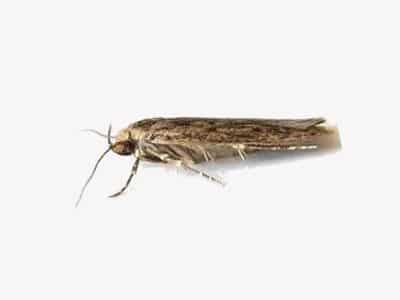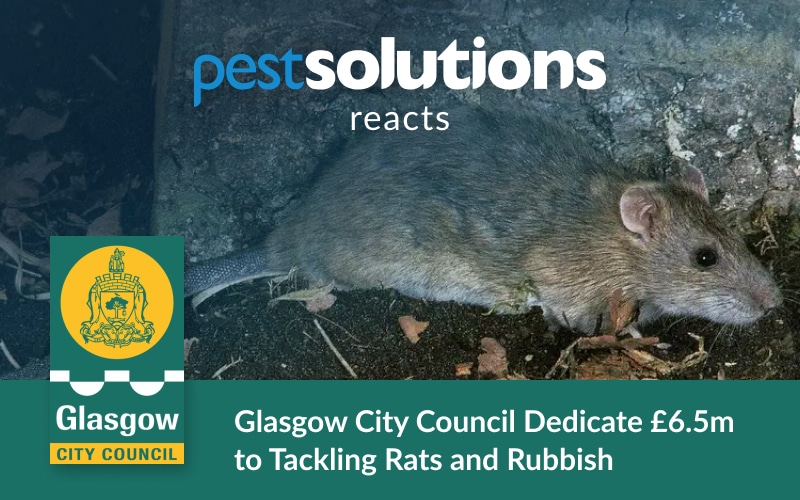About Hide Beetle
Hide beetles (Dermestes maculatus) are a type of dermestid beetle commonly found worldwide. Known for their scavenging habits, these beetles are often associated with animal carcasses and hides, playing a crucial role in ecological systems by helping to break down organic matter. Due to this behaviour, if present in the wrong place, these insects can cause significant damage to valuable items such as leather goods, fur, and taxidermy specimens.
Pest Solutions are here to help with hide beetle problems. Get the details of your local Pest Solutions Branch here or call our national advice line on 0800 027 2555 to arrange a FREE survey or a service visit.
Identifying Hide Beetle
Adult hide beetles are small, dark insects, approximately 6-11mm in length. They have an elongated oval shape and are covered in dark brown to blackish-brown scales. Adults typically have a distinctive yellowish band across their backs while larvae are C-shaped and covered in bristle-like hairs.
Signs of Hide Beetle Infestation
If a hide beetle infestation is present, you may notice these small, dark coloured beetles or their larvae in or around infested materials. You may also find an accumulation of shed skins and faecal matter in infested areas.
Hide beetles are named for their affinity for hides and skins, particularly those of mammals and as such they can damage leather products and fur.
These beetles are often associated with carcasses of dead animals, including rodents and birds, as they help break down the organic matter. Hide beetle larvae have been known to infest bird nests, particularly abandoned nests in buildings or attics. So, if you notice these beetles in your property, they could be a sign of another problem.
However, they may also be found infesting stored food items, including grains, cereals, and pet food, if not properly sealed and stored.
Hide Beetle Biology & Lifecycle
The hide beetle undergoes a complete metamorphosis which includes 4 life cycle stages: Egg, Larva, Pupa and Adult.
Adult female hide beetles typically lay their eggs near a suitable food source. The eggs are usually laid in clusters or hidden in crevices, cracks, or other sheltered locations. Female hide beetles can lay hundreds of these tiny, white or cream-colored eggs over their lifespan.
After a period of incubation, the eggs hatch into larvae. Hide beetle larvae are the primary damaging stage. They are elongated, C-shaped, and covered in bristle-like hairs.
Larvae have a voracious appetite and feed on organic materials, such as animal hides, dried meat, and other protein-rich substances. As they grow, hide beetle larvae moult several times, shedding their exoskeletons to accommodate their increasing size. The larval stage can last for several weeks to several months, depending on environmental conditions and food availability.
When hide beetle larvae reach a certain size, they enter the pupal stage. During this stage, the larvae spin a protective cocoon made of silk and debris, which serves as a shelter for their transformation. Inside the cocoon, the larva undergoes metamorphosis, gradually transforming into an adult beetle. The pupal stage typically lasts for a couple of weeks, but duration can vary and is also based on environmental factors.
After completing the pupal stage, an adult hide beetle emerges from the cocoon. Adult hide beetles are capable of flight and are responsible for mating and laying eggs to start the lifecycle anew. The adult stage of hide beetles can live for several months, during which they continue to seek out suitable food sources and reproduce.
The hide beetle’s lifecycle can vary in duration depending on factors like temperature, humidity, and the availability of food. In warmer conditions with an abundant food supply, the lifecycle may be shorter, while it may extend in cooler or less favourable environments.
Hide Beetle Behaviour
Hide beetles are primarily scavengers, feeding on decaying organic matter, including animal carcasses, hides, and other protein-rich materials. They are attracted to the scent of decomposition, making them important in nature’s cleanup crew, helping to break down and recycle organic matter.
Hide beetles are typically nocturnal, being more active at night. They are often found foraging in the dark or in secluded areas where they can locate suitable food sources.
Hide beetles prefer dark and concealed environments, which provide protection from predators and exposure to the elements. They can often be found in cracks, crevices, and other hiding spots in buildings and storage areas.
In some cases, hide beetles may aggregate in groups, especially when they locate a rich food source. Aggregation can lead to rapid infestations, particularly in areas with favourable conditions.
In adverse environmental conditions, hide beetles can enter a state of diapause, a form of dormancy that allows them to survive until environmental conditions become more favourable for activity and reproduction.
Risk of Hide Beetle Infestation
A hide beetle infestation poses risks and challenges in both commercial and domestic settings.
Hide beetle larvae can cause significant damage to valuable items made of organic materials, such as leather products, fur coats, taxidermy specimens, textiles, and natural history collections.
Hide beetles are associated with decaying organic matter and can introduce harmful bacteria. Their presence can raise concerns about hygiene, particularly in food storage or preparation areas. In food storage areas, hide beetles can infest and contaminate stored food products, rendering them unfit for consumption. They can contaminate food with insect body parts, eggs, shed larval skins and faecal matter.
Significance of Controlling Hide Beetle
Infestation by hide beetles can cause severe damage to valuable items such as leather goods, fur, and taxidermy specimens. In some cases, hide beetles may infest carpeting and upholstered furniture, especially if there is organic debris or spills present. As such, infestations can cause significant economic losses for homes and businesses, as well as the potential destruction of cherished possessions.
In museums and natural history collections, hide beetles can damage preserved animal specimens, including bones and dried insects.
Considering the risks associated with hide beetle infestations, it is essential to implement proactive measures for prevention, regular inspection and if necessary professional pest control to mitigate the potential negative consequences of an infestation. Proper storage and hygiene practices are crucial in reducing the risk of hide beetle problems in all settings.
Controlling Hide Beetle Infestations
Hide beetles have a relatively short lifecycle, and a single infestation can quickly grow in numbers if not addressed promptly. This rapid reproduction can make infestations challenging to control. Integrated pest management is important when controlling hide beetles.
If a hide beetle infestation is discovered, all infested materials or contaminated items should be isolated and removed to prevent the infestation spreading further. The affected area should be cleaned thoroughly with special attention paid to cracks, crevices and other areas of harbourage.
For severe or persistent infestations, a qualified pest management professional will be able to advise on the best integrated treatment plan which may include specialised treatments.
Remember that hide beetles can be resilient, and it may take time and persistence to completely eradicate an infestation. Combining multiple control methods and addressing the conditions that attracted hide beetles to the area in the first place are essential for long-term control and prevention. In all cases, a qualified pest management professional will be able to select the best tools to solve the problem.
Preventing Hide Beetle Infestations
When dealing with hide beetles, prevention is more effective and less costly than dealing with an infestation once it has taken hold. By implementing preventive measures and being proactive in managing potential risks, you can significantly reduce the likelihood of hide beetle problems.
Maintain good hygiene in storage areas, especially those with organic materials. Regularly clean and vacuum storage spaces to remove debris that might attract hide beetles.
Keeping the temperature and humidity levels in the infested area low can discourage hide beetle activity and reproduction.
Maintaining proper ventilation and humidity control, especially in storage areas for high-risk items, will also make conditions less favourable for hide beetles. Regular inspection and monitoring within high-risk areas is also recommended to allow for early detection of pest activity.
DIY Pest Control
Hide beetles can be resilient and challenging to eradicate completely, especially if they have infested hard-to-reach areas or hidden cracks and crevices. This difficulty often necessitates professional pest control services.
When to Call a Professional
For effective hide beetle control, especially when infestations are extensive or valuable items are being damaged, it is best to consult with a qualified pest management professional. Professionals can accurately identify the cause of the problem, implement appropriate treatments and provide guidance on preventive measures to prevent reinvasion.
If the conditions that initially attracted hide beetles to an area are not addressed, infestations may recur even after treatment, leading to ongoing pest management challenges.
Call Pest Solutions to Get Rid of That Beetle Today!
Pest Solutions have local Branches across Scotland, England, Wales and Northern Ireland. Our expert local techs are at hand to attend today. Call now to get an experienced Pest technician visit and get that Pest problem under control swiftly.
Get the details of your local Pest Solutions Branch here or call our national advice line on 0800 027 2555 to arrange a FREE survey or a service visit.
Find out more about how to get rid of Hide Beetles



















